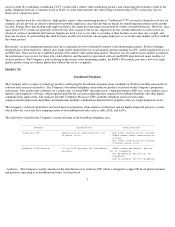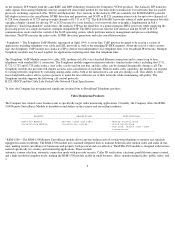8x8 1999 Annual Report Download - page 8
Download and view the complete annual report
Please find page 8 of the 1999 8x8 annual report below. You can navigate through the pages in the report by either clicking on the pages listed below, or by using the keyword search tool below to find specific information within the annual report.market trend has been to bring IP to the "edge" of the network, i.e. to extend the IP component of the call from the backbone to the customer
premises.
A limiting factor for converged voice, video and data networks, particularly for residences and small businesses, has been the "last mile" of the
network connection to the customer premises from the local exchange of the provider of network services. For residential applications, the last
mile is usually a POTS telephone line, which is limited in bitrate to 56 Kbps downstream (i.e. from the exchange to the residence) and 33.6
Kbps upstream. Higher speed residential connections such as ISDN exist, but deployment of ISDN has been slowed by limited availability and
expensive service. Recently, however, a new group of broadband access technologies has emerged that dramatically increases the bandwidth
available for delivery of voice, video and data into the home. These technologies, including cable modems, DSL and high-bandwidth wireless
local loop, offer high-speed connections to the Internet (ranging from several hundred Kbps to several megabits per second), are relatively low
cost (typically a few hundred dollars for installation and $40 to $80 per month for service), and enable a multimedia IP communication. To date
the deployment of broadband access technologies has been relatively small with a total installed base of a few million, but the deployment is
expected to accelerate over the next several years and eventually penetrate a significant fraction of U.S. households. Adding to the potential of
broadband access is the emergence of home networks, which connect PCs and communication appliances to each other and to the Internet at
high speeds. These technologies will enable non-traditional telephone service providers such as cable operators and ISPs to compete with
RBOCs to provide telephony services to consumers. These services will include basic dial tone, multiple phone lines, conference calling, web-
based provisioning and billing, videoconferencing and video on demand.
While the value proposition for IP communications thus far has been to reduce the charges for long-
distance voice calls, the ultimate success of
IP communications will depend on its ability to provide services and features that exceed the capability of switched-circuit networks. These
services and features will leverage the connectivity, scalability and open architecture of the Internet. For example, IP communications allow a
customer to provision a second or third line in his house over the Internet using a standard web browser, without requiring a visit from an
installer or even a call to the phone company. The second or third line can be provided at a small incremental cost, allowing the customer to
save money while the service provider increases its profits compared to the same scenario in the traditional switched circuit model.
In order for the IP communications market to continue to grow, several things need to occur. First, IP networks must improve their QoS for
real-time communications, managing effects such as packet jitter, packet loss and unreliable bandwidth, so that toll-quality service can be
provided. Second, IP communications equipment must achieve "five-nines" reliability that users of the PSTN have come to expect from their
telephone service. Third, IP communications service providers must offer cost and feature benefits to their customers that are sufficient to cause
the customers to switch away from traditional telephony service providers.
Video Monitoring
A growing number of businesses worldwide are installing new security systems that incorporate video monitoring or are expanding their
existing systems to include video monitoring. Today the most common video monitoring product is closed-circuit TV (CCTV) security. Both
large and small businesses use CCTV security systems and the market spans a wide range of applications and product types. CCTV systems are
generally installed at a business location and, unless there is a guard at the location who can watch video monitors, the systems are used strictly
for recording and archival purposes. The CCTV system records and stores all of the activity in view of the cameras. The video is typically not
viewed real time and is used to review employee activity or as evidence in the event a crime is captured on tape. CCTV systems typically
consist of any number of cameras, video switchers and video tape recorders.
Until recently, CCTV systems were, as the name indicates, "closed-circuit" -- all the components of the system, including the monitor, had to
be wired together and therefore, had to be in the same general location. Remote video monitoring products allow the user to move outside the
confines imposed by a traditional closed
4





















